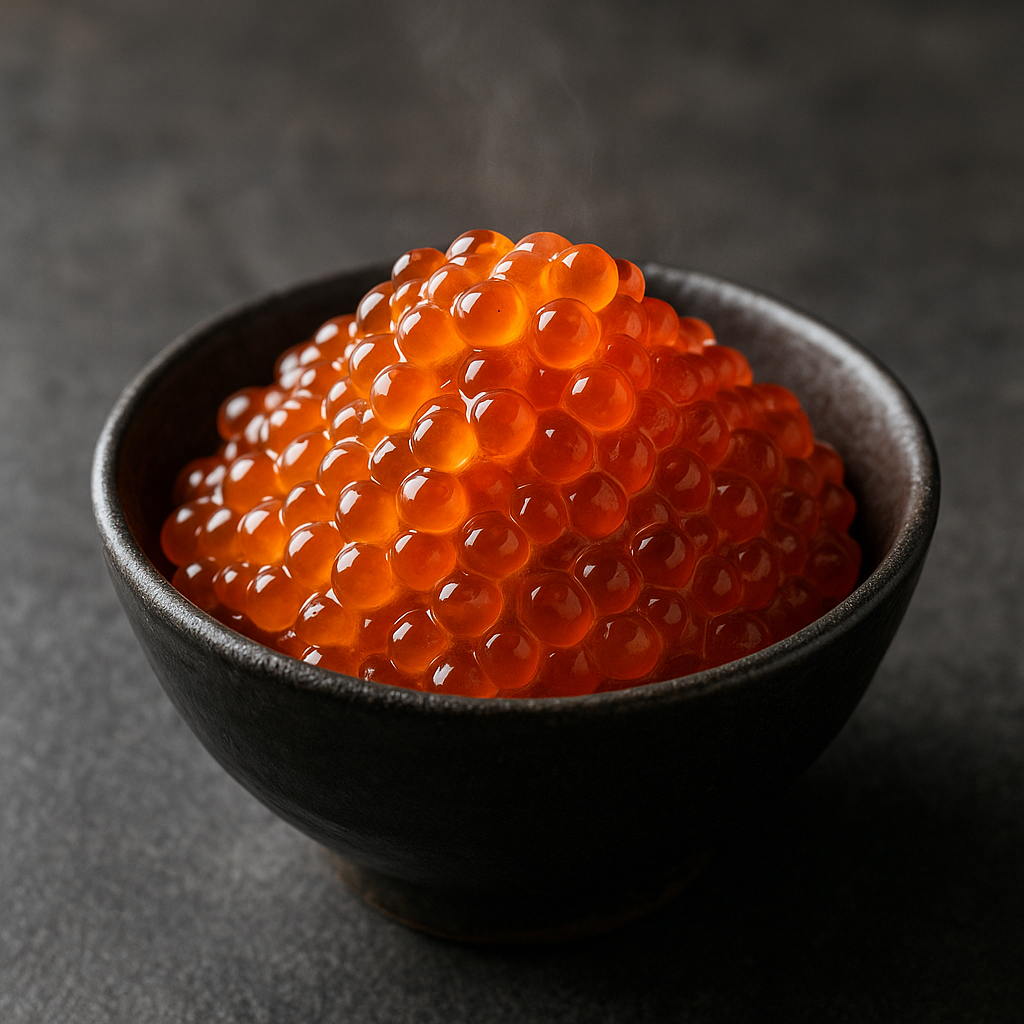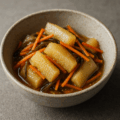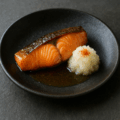いくらの醤油漬けの特徴
北海道を代表する味覚
いくらの醤油漬けは、北海道の代表的な海産物料理で、新鮮な鮭の卵を醤油ベースのタレに漬け込んだものです。プチプチとした食感と濃厚な旨味が特徴です。
シンプルながら贅沢
素材の鮮度が命で、シンプルな醤油ダレに漬けることで鮭卵本来の甘みと旨味を引き立てます。ご飯や寿司の具材としても定番です。
保存食から家庭料理へ
かつては秋の鮭漁の時期に仕込まれた保存食でしたが、現在では家庭やお店でも広く楽しまれるようになりました。
いくらの醤油漬けのレシピ
材料(4人分)
- 生すじこ … 200g
- 醤油 … 100ml
- みりん … 大さじ2
- 酒 … 大さじ2
- 昆布 … 5cm角1枚
作り方
- 生すじこを40℃程度のぬるま湯に浸し、優しくほぐしていくらを取り出す。
- 数回水を替えて血や膜を洗い流し、水気を切る。
- 鍋に醤油・みりん・酒・昆布を入れて軽く煮立て、冷ます。
- いくらを保存容器に入れ、冷めた調味液を注ぐ。
- 冷蔵庫で一晩以上漬け込めば完成。
シェフのワンポイントアドバイス
ぬるま湯で筋子をほぐすのが苦手な人はボウルの上に焼き魚の網を置き、筋子を円を描く様に優しく押し付けると簡単にほぐれます。
調味液は必ず冷ましてから加えることで、いくらの皮が硬くなるのを防げます。
酒の風味が嫌いではないのならば加熱せずにそのまま漬け込むのも良いですね。
冷凍保存も可能ですが、食感が少し変わるのでなるべく早めに食べ切るのがおすすめです。
いくらの醤油漬けの栄養価(1人分の目安)
- エネルギー:約200〜250 kcal
- たんぱく質:20〜25 g
- 脂質:10〜15 g(鮭卵由来の良質な脂質)
- 炭水化物:2〜3 g(調味料由来)
- ビタミンA・D・B群(鮭卵由来)
- EPA・DHA(血流改善・脳機能維持に効果)
高たんぱくで良質な脂質を含み、滋養強壮にも優れた一品です。
いくらの醤油漬けの歴史
秋鮭漁と保存食
北海道では秋の鮭漁とともに、すじこをほぐして醤油に漬ける「いくらの醤油漬け」が家庭で作られてきました。
名称の由来
「いくら」という言葉はロシア語の「икра(魚卵)」に由来しており、北海道の歴史と深い関わりがあります。
郷土料理から全国へ
鮭の名産地・北海道の郷土料理として発展し、現在では全国の食卓や寿司店で定番の食材として親しまれています。
English Version
Features of Ikura Shoyu-zuke (Soy Sauce Marinated Salmon Roe)
A Representative Taste of Hokkaido
Ikura Shoyu-zuke is one of Hokkaido’s signature seafood dishes, made by marinating fresh salmon roe in a soy sauce–based seasoning. It is known for its popping texture and rich umami flavor.
Simple Yet Luxurious
Freshness is essential. By marinating in a simple soy sauce mixture, the natural sweetness and flavor of the salmon roe are highlighted. It is a classic topping for rice bowls and sushi.
From Preserved Food to Household Dish
Originally prepared during the autumn salmon season as a preserved food, today it is widely enjoyed at home and in restaurants across Japan.
Recipe
Ingredients (for 4 servings)
- Fresh sujiko (salmon roe in sacs) … 200 g
- Soy sauce … 100 ml
- Mirin … 2 tbsp
- Sake … 2 tbsp
- Kombu … 1 piece (about 5 cm square)
Instructions
- Soak the sujiko in lukewarm water (about 40℃) and gently separate the roe.
- Rinse several times in fresh water to remove blood and membranes, then drain thoroughly.
- In a saucepan, combine soy sauce, mirin, sake, and kombu. Bring briefly to a simmer, then cool completely.
- Place the salmon roe in a container and pour the cooled seasoning liquid over it.
- Marinate in the refrigerator for at least one night before serving.
Chef’s Tip
If separating the roe by hand is difficult, place the sujiko on a grill net over a bowl and gently rub in circles to release the roe. Always cool the seasoning liquid before adding to prevent the roe skin from hardening. If you enjoy the flavor of sake, you can skip heating and marinate the roe directly. Freezing is possible, though the texture may change slightly, so it’s best enjoyed fresh.
Nutritional Value (per serving, approx.)
- Calories: 200–250 kcal
- Protein: 20–25 g
- Fat: 10–15 g (high-quality fats from salmon roe)
- Carbohydrates: 2–3 g (from seasoning)
- Vitamins A, D, and B group
- EPA & DHA (support circulation and brain health)
Ikura is rich in protein and beneficial fats, making it a nourishing and stamina-boosting dish.
Historical Background
Autumn Salmon Fishing and Preservation
In Hokkaido, families traditionally prepared Ikura Shoyu-zuke during the autumn salmon season, marinating roe from sujiko as a means of preservation.
Origin of the Name
The word “ikura” comes from the Russian word ikra (meaning fish roe), reflecting Hokkaido’s historical ties with northern cultures.
From Local Specialty to National Favorite
Born as a regional dish in Hokkaido, Ikura Shoyu-zuke has become a staple across Japan, widely enjoyed at home and in sushi restaurants nationwide.



何でも質問してください!